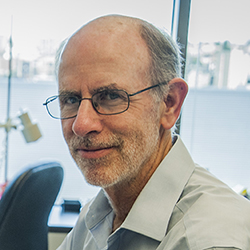Morgan Laboratory
The Morgan laboratory pioneered the use of C. elegans- a simple invertebrate - to understand the relationship between mitochondrial dysfunction and anesthetics. By investigating how volatile anesthetics trigger a range of behaviors in mutant animals, Morgan identified key molecules that control how C. elegans responds to anesthetics. His laboratory is actively investigating molecules that can reverse the shortened life spans and neurological defects of animals with mitochondrial dysfunction.
Morgan's team is using the same animal to understand anesthesia's possible long-term effects on newborns and infants.
The Morgan laboratory works closely with Dr. Margaret Sedensky's laboratory to understand why a mouse with a particular mitochondrial defect is sensitive to gas anesthetics. Morgan is also exploring how this defect causes cells in particular brain regions to degenerate - a hallmark of mitochondrial disease in children.
In addition to his research, Morgan is a pediatric anesthesiologist who cares for many children with mitochondrial disease at Seattle Children's Hospital.
Lab News
Sedensky, Morgan Honored by American Society of Anesthesiologists
October 15, 2023 – Drs. Marge Sedensky and Phil Morgan, Norcliffe Foundation Center for Integrated Brain Research, recognized with national Excellence in Research award for their pioneering studies in how anesthetics work and making them safer for children with mitochondrial disease.
Answering a Century-Old Question: How Do Gas Anesthetics Work in the Brain?
June 9, 2022 – In their paper published in Current Biology, Drs. Phil Morgan and Margaret Sedensky are the first to discover how gas anesthetics cause unconsciousness at the cellular level.
Investigator Biography

Phil Morgan, MD
Phil Morgan, MD, is a principal investigator at Seattle Children's Research Institute. He is also a professor in the Department of Anesthesiology and Pain Medicine at the University of Washington. He came to Seattle Children's in 2008 after working more than 20 years at Case Western Reserve University, where he and Margaret Sedensky, MD, became recognized as leaders in understanding anesthetic interactions in mitochondrial disease. He received an MD from the University of Colorado School of Medicine. He completed a residency and fellowship in anesthesiology at the University Hospitals of Cleveland, and a fellowship in pediatric anesthesiology at the University of Washington.
Selected Publications
Dr. Phil Morgan has authored many research papers, including the selected publications listed below.
- Humphrey, JA, Hamming, KS, Thacker CM, Scott RL, Sedensky, MM, Snutch TP, Morgan, PG, Nash HA. An Unusual Cation Channel and its Novel Regulator Show Cross-Species Conservation of Effects on General Anesthesia, Curr Biol, 17 (7):624-9, 2007.
- Falk MJ, Zhang Z, Rosenjack JR, Nissim I, Daikhin E, Nissim I, Sedensky MM, Yudkoff M, Morgan PG. Metabolic pathway profiling of mitochondrial respiratory chain mutants in C. elegans. Molec Genet Metab. 93 (4):388-97, 2008.
- Singaram VK, Somerlot BH, Falk SA, Falk MJ, Sedensky MM, Morgan PG. Optical reversal of halothane-induced immobility in C. elegans. Curr Biol. 21;2070-2076, 2011.
- Suthammarak W, Somerlot BH, Opheim E, Sedensky M, Morgan PG. Novel interactions between mitochondrial superoxide dismutases and the electron transport chain. Aging Cell 12 (6):239-50, 2013.
- Quintana A, Morgan PG, Kruse SE, Palmiter RD, Sedensky MM. Altered anesthetic sensitivity of mice lacking Ndufs4, a subunit of mitochondrial complex I. PLoS One 7;e42904, 2012
- Johnson SC, Yanos ME, Kayser EB, Quintana A, Sangesland M, Castanza A, Uhde L, Hui J, Wall VZ, Gagnidze A, Oh K, Wasko B, Ramos FJ, Palmiter R, Rabinovitch P, Morgan PG, Sedensky MM, Kaeberlein M. mTOR Inhibition by Rapamycin Alleviates Mitochondrial Disease 1 in the Ndufs4 -/- Mouse Model of Leigh Syndrome. Science;342 (6165):1524-8, 2013.
